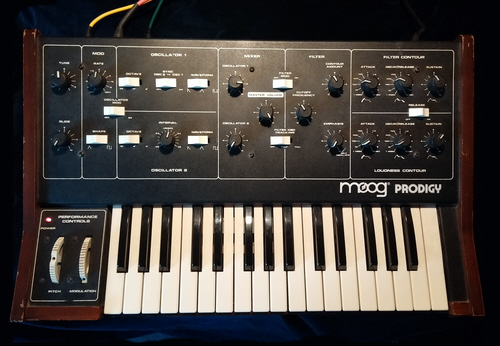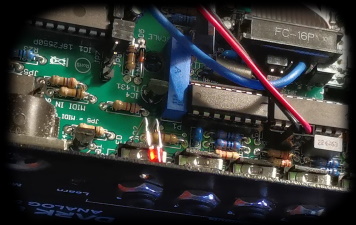Kjartan Poskitt's Vintage Synthesiser Page
|
|
VIDEOS featuring:
|
|
|
How a Vintage Synthesiser works -
featuring the Moog Prodigy.
The Moog Prodigy is one of the simplest, but one of the best old music synthesisers. This video shows exactly what the different bits of a synthesiser do, what the various switches and knobs are for and how it can pretend to be other instruments!
|
 |
|
|
|
|
|
|
Good Times with Dark Times
Doepfer Dark Time sequencers have 40 switches, 18 knobs, four buttons and 12 cv/gate sockets (plus midi). This video shows two of them creating some stunning vibes as they control three synths and a drum box at once... and this is only a tiny glimpse at what they can do!
|
 |
|
|
|
|
|
|
What's odd about The Odyssey?
The original ARP Odyssey came out in the 1970's as a rival to the Minimoog, and offered a wealth of different features. Korg have now re-launched it with extras including midi and a choice of filters.
This guide features a vintage ARP Odyssey Mk1 2800 model built in 1975, and shows off the duophonic VCOs (with a total range of over 14 octaves!), PWM, filter, shapers and voltage patching. Gate and Trig (T-gate) inputs are explained, plus you get to see inside!
|
 |
|
|
|
|
|
|
The Legendary Korg MS-20
This detailed introduction to the Korg MS-20 follows on from "How a Vintage Synthesiser Works". It shows how the MS-20's patch board can be hooked up to get the best from voltage control modules including the VCOs, VCAs, High and Low Pass VCFs, the Ring Modulator and noise generators. Although the machine featured was built in the 1970's, Korg have now produced the Korg MS-20 Mini which has all the same features to play with!
|
 |
|
|
|
|
|
|
How to tame a Ring Modulator!
Ring Modulators are the strangest effects in music, but how do they work? This video shows how a variety of different Ring Mods create space wars, ghostly church bells and Dalek voices. There's also my own invention, the 40 year old "Twing Mod" made from three classic old Dewtron synthesiser modules.
|
 |
|
|
|
|
|
|
Echoes of Delight
Analog delay uses the old "bucket chips" to produce echoes that slowly evolve as they repeat. Here I use the classic MOOG MF-104Z to show how these chips work, what happens when you shove modulation voltages into it and what it sounds like with different effects in the loop circuit. Lots of chunky pedals in this one.
|
|
|
|
|
|
|
What's that noise?
Most sythesisers have a white noise generator, but what exactly is it, and how do you make the wildest and weirdest wind noises? Random voltages and the "sample and hold" function are explained with the help of the Moog filter, the CP-251 and the Korg MS-20.
|
|
|
|
|
|
|
Making Waves
This is my attempt to recreate the fabulous sounds made by the waves hitting the shingle beach at Deal in Kent, England.
Here's a short demo video of the final result ...
|
|
|
I use the Moog Voyager and Korg MS-20, the Moogerfooger MF-104Z analog delay, MF-103 phaser and MF-105M Murf, plus the Arp Odyssey to add bird noises.
There is also a little montage showing The Top Five Best Things In Deal including the pubs, the castle, the excellent Time Ball Tower Museum and "Carry On" star Charles Hawtrey.
|
|
|
|
|
|
|
What on Earth's a MuRF?
Moog have made a pedal with eight resonant filters and lots of other knobs and buttons, but what can you do with it? It's all here, plus I reveal its secret weapon and show how it uses prime numbers to do the most nerdish thing in music!
|
|
|
|
|
|
|
Dark Night Dark Times Dark Energies
A little midnight session featuring the Doepfer Dark Time sequencers and Dark Energy synths, along with a few other odd noises.
|
|
|
|
|
|
|
Syncing Dark Energies
Dark Energy synths made by Doepfer only have one oscillator, one filter, one ADSR envelope generator and two LFOs, but they can produce a wide and wild selection of sounds.
What's more, the tech manuals show how to access voltage pins on the circuit boards to give more options. This video shows how to install the glide mod, and how to convert the CV4 socket on the back of a Dark Energy II into a hard sync input. This gives some awesome riffs when connected to a Dark Energy I !
|
 |
|
|
|
|
|
|
How to make a DFAM
The Moog DFAM (Drummer From Another Mother) sounds amazing, but surely with a bit of thought I can re-create it? All it needs is a Voyager, a Dark Time, a Dark Energy, a Murf, a CP251 processor and about 30 wires. If all else fails, there's some great cartoon noises from the 1970's Moog Prodigy!
|
|
|
|
|
|
|
The Laid-Back DFAM
I borrowed a Moog DFAM and hooked it up with everything else including my new Behringer Edge, then stumbled on a really nice riff. Not the usual DFAM dance track, but great funky sounds, and yet again, the new gear is joined by the 50-year old Moog Prodigy!
|
|
|
|
|
|
|
The DFAM, the EDGE and the Happy Pig
Although the DFAM and its clone the EDGE both have an 8 step sequencer, I wanted to break away with a strange time signature. Using the Dark Time sequencers and the CRAVE, this tune is in 15/8 and features the old ARP ODYSSEY plus the DFAM making some very unexpected sounds!
|
|
|
|
|
|
|
When Three Dark Energies Met A Crave
This was supposed to be a sequencer demo, but I got carried away, especially with my new toy the Behringer Crave!
|
|
|
|
|
|
|
Chillin' with the Grind
Here's how I put together an ambient riff featuring the extraordinary Behringer Grind.
|
|
|
|
|
|
|
Santa's 7/4 Sequence
A short demo showing how sequencers don't have to stick to a 4/4 rhythm! Featuring the Dark Times, Dark Energies, Korg SQ1, Moog Voyager and Moog Delay and a ghostly reindeer.
|
|
|
|
|
|
|
A Dark Energy singing to itself
Sometimes the best things are the simplest! Just one filter and one oscillator randomly jam together making a dreamy little soundscape.
|
|
|
|
|
|
|
The Ring Modulator Bell
The Moog Ring Mod combines with two Dark Energies to give some really rich, deep and spooky bell tones.
|
|
|
|
|
|
|
Cat and Dog!
Just because synthesisers have keyboards, it doesn't mean that they have to play a tune.
This was my very first video featuring the KORG MS20 as the "cat" and the ARP ODYSSEY as the "dog".
|
|
|
|
|
Hopefully there will a few more videos to come showing other synths, effects pedals and lots of weird noises!
|
|
|
|





